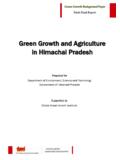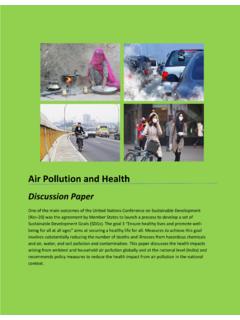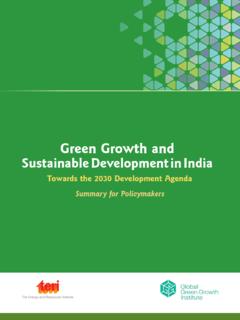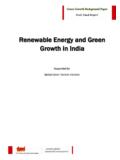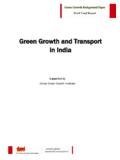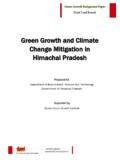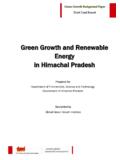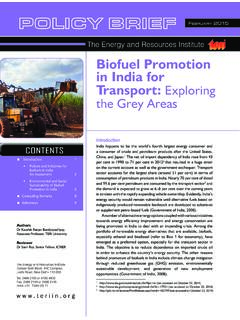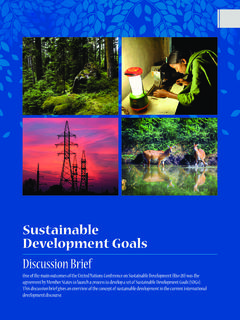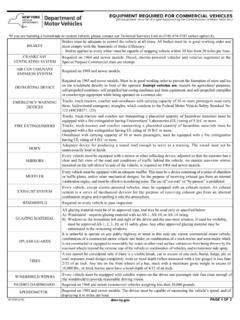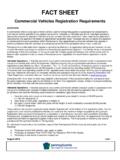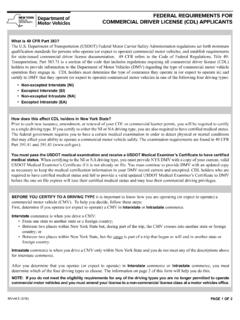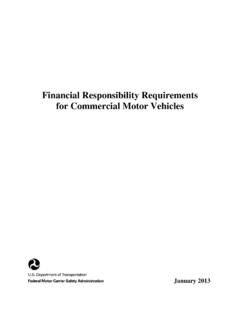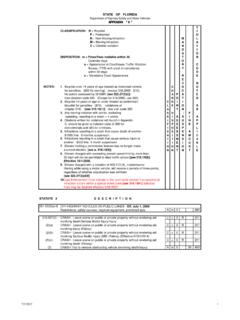Transcription of FASTER ADOPTION OF ELECTRIC VEHICLES
1 FASTER ADOPTION OFELECTRICVEHICLESIN INDIA: PERSPECTIVEOF CONSUMERS ANDINDUSTRYTHE ENERGY AND RESOURCES INSTITUTEC reating Innovative Solutions for a Sustainable Future The Energy and Resources Institute 2019 Society for Development Studies 2019T E R I. 2019 FASTER ADOPTION of ELECTRIC VEHICLES in India: Perspective of consumers and industryNew Delhi: The Energy and Resources Institute. For more information Aravind Harikumar T E R I Tel. 46444500 or 24339606-08 Darbari Seth Block E-mail I H C Complex, Lodhi Road Fax 24339609 New Delhi 110 003 Web i i n .org India India +91 Delhi (0)11 FASTER ADOPTION OF ELECTRIC VEHICLES IN INDIA: PERSPECTIVE OF CONSUMERS AND INDUSTRYiTABLE OFCONTENTSEXECUTIVE SUMMARY ix Mobility Scenario in India ix Role of ELECTRIC VEHICLES in India s Mobility Scenario ix Emission and Energy Impact of Electrification of Two-Wheelers in India x Perspective of Consumers in Electrification of Two-Wheelers x Business Feasibility and Overall Expected Charging Infrastructure Requirement xi Industry s Perspective in Electrification of Two-Wheelers xi Business and Financing Models xii1.
2 BACKGROUND OF THE STUDY 1 Objectives of the Study 1 Scope 4 Methodology 42. MOBILITY SCENARIO IN INDIA 7 Overview 7 Mobility Pattern in Indian Cities 9 Mode share in Indian cities 9 Mode preference and trip length for work purpose 11 Role of various modes 13 Transport-related Externalities 13 Enhancing energy security 13 Greenhouse gas mitigation 14 Reduce local pollution 14 Alternative Fuel Technology Solutions 15 CNG 15 Bio-fuels 15 ELECTRIC VEHICLES 16 Hydrogen fuel-cell 16 FASTER ADOPTION OF ELECTRIC VEHICLES IN INDIA: PERSPECTIVE OF CONSUMERS AND INDUSTRYii3. ELECTRIC VEHICLES AS A POTENTIAL SOLUTION 17 Overview of Indian Automotive Sector 17 vehicle production in India 18 vehicle sales in India 19 Policy Framework Supporting Electrification in India 19 National level policies and interventions 19 State level policies 21 Front Runners vehicle Segments 22 Potential and Importance of Electrification of Two Wheelers 24 Assessment of two-wheeler segment for electrification4.
3 EMISSION AND ENERGY IMPACT OF ELECTRIFICATION OF TWO-WHEELER SEGMENT 27 Analysis Framework 27 Travel Demand and vehicle Segmentation 28 Assumptions for ELECTRIC Two-Wheeler Share 28 Alternate ELECTRIC Two-Wheeler Uptake Scenarios 30 A Brief Review of Life Cycle Emissions of EVs and ICEs 315. CONSUMERS PERSPECTIVE 33 Current e-2w Market 33 E-2w Sales trend 33 Consumer Survey 34 Survey results of potential and existing ELECTRIC two-wheeler owners 34 Survey Results of Potential ICE 2w Owners 376. AN ECOSYSTEM FOR ELECTRIC TWO-WHEELERS (FEASIBILITY STUDY) 41 Private Charging 41 Public Charging Station 42 Cost to the Economy for PCS Ecosystem 44 Battery Swapping Ecosystem 467. INDUSTRY S PERSPECTIVE 51 Employment Effects (NSDC 2016) 51 Effect on Value Added (SIAM 2017, ACMA 2018) 51 SIAM, White Paper 2017 52 Results from Industry Stakeholders Interviews 53 Market for ELECTRIC two wheelers in India 53 Issues from the paradigm shift to ELECTRIC 54 Issues from current policy at national and state levels 54 Policy support required for FASTER ADOPTION of ELECTRIC VEHICLES 548.
4 BUSINESS AND FINANCING MODELS 57 Innovative Approaches to Promote Uptake of ELECTRIC Two-Wheelers 579. CONCLUSION 59 FASTER ADOPTION OF ELECTRIC VEHICLES IN INDIA: PERSPECTIVE OF CONSUMERS AND INDUSTRYiiiTable 1: CAGR of registered VEHICLES 8 Table 2: Average annual rate (%) of change of the urban population 9 Table 3: Mode share of public transport in different cities (%) 10 Table 4: Mode share of personalized modes 10 Table 5: Trend in average motorized trip length in Indian cities 10 Table 6: Distance travelled for work purpose 12 Table 7: State-level EV policies and their targets 22 Table 8: Ranking of vehicle segments based on criteria used for identification of low-hanging fruits/front runners 25 Table 9: ELECTRIC two-wheeler sales through FAME subsidy 33 Table 10.
5 Summary of PCS feasibility study 44 Table 11: Assumed utilisation rates at a PCS 45 Table 12: Cost per km for 2w sourcing energy from different sources 46 Table 13: Lithium battery prices scenarios 47 LIST OF TABLESFASTER ADOPTION OF ELECTRIC VEHICLES IN INDIA: PERSPECTIVE OF CONSUMERS AND INDUSTRYivFASTER ADOPTION OF ELECTRIC VEHICLES IN INDIA: PERSPECTIVE OF CONSUMERS AND INDUSTRYvFigure 1: Registered private VEHICLES (numbers in millions) 7 Figure 1: Registered private VEHICLES (in millions) 7 Figure 2: Registered public and Intermediate Pubic Transport (IPT) VEHICLES (in millions) 8 Figure 3a: On-road passenger VEHICLES stock in India from 2001 02 to 2016 17 and (projected) 2016 17 to 2030 31 8 Figure 3b: Estimated CO2 emissions from vehicle segments in 2017-18 8 Figure 3c: Estimated Energy consumption from vehicle segments in 2017-18 8 Figure 4: Estimated share of passenger transport modes by 2030 8 Figure 5: Average share of households owning two-wheelers 10 Figure 6: Urban and rural mode used for work trips in India 11 Figure 7: Mode used for work trips in Delhi 12 Figure 8: Urban rural mode use for work 12 Figure 9: India (rural) trip length distribution 12 Figure 10: India (urban) trip length distribution 12 Figure 11: Delhi - trip length distribution (Census 2011) 13 Figure 12.
6 Total production of automobiles 17 Figure 13: Segment-wise trend of vehicle production 18 Figure 14: Total sales of automobiles (2016 17) 18 Figure 15: Segment-wise trend of vehicle sales 19 Figure 16: Estimated share of various transport modes in 2030 23 Figure 17: On-road stock of two-wheelers in urban and rural India 28 Figure 18: Sales of E-2w using FAME subsidy (April 2015 to June 2019) 34 Figure 19: Summary of online stated preference survey of respondents 34 LIST OFFIGURESFASTER ADOPTION OF ELECTRIC VEHICLES IN INDIA: PERSPECTIVE OF CONSUMERS AND INDUSTRYviFigure 20: Summary of respondents planning to buy a two-wheeler in the near future 34 Figure 21: Motivation present e-2w owners for their choice of e-2w 35 Figure 22: Motivation potential e-2w owners for their choice of e-2w 35 Figure 23: Anxiety regarding EV attributes: present and potential e-2w owners 35 Figure 24: Convenience of location for charging: present and potential e-2w owners 36 Figure 25: Willingness to pay at the public charging station: present e-2w owners 36 Figure 26: Willingness to pay at the public charging station: potential e-2w owners 36 Figure 27: Willingness to wait at a public charging station: present e-2w owners 37 Figure 28: Willingness to wait at a public charging station: potential e-2w owners 37 Figure 29: Reasons for not choosing ELECTRIC .
7 Potential ICE 2w owners 37 Figure 30: Perception of concerns regarding e-2w (potential ICE 2w owners) 38 Figure 31: Perception of EV in relation to ICE (potential ICE 2w owners) 39 Figure 32: Willingness to pay for similar performing e-2w (potential ICE 2w owners) 39 Figure 33: Feasibility of public charging station (with land costs) 43 Figure 34: Covering AVC (without land costs) 43 Figure 35: Break-even (without land costs) 44 Figure 36: Annual charging costs to ecosystem, including all annual capital and variable costs 45 Figure 37: Annual charging costs to ecosystem per e-2w, including all annual capital and variable costs 46 Figure 38: Variable costs per swap (optimistic scenario battery swapping station) 47 Figure 39: Costs per km for e-2w in a swapping ecosystem (optimistic scenario) 47 Figure 40: Variable costs per swap (pessimistic scenario battery swapping station) 48 Figure 41: Costs per km for e-2w in a swapping ecosystem (pessimistic scenario) 48 FASTER ADOPTION OF ELECTRIC VEHICLES IN INDIA: PERSPECTIVE OF CONSUMERS AND INDUSTRYviiTERI would also like to thank our partners in the study, Society for Development Studies (SDS).
8 We are grateful to Mr. Hemant Krishan Singh, Director General, SDS; Dr. Didar Singh, Senior Fellow, SDS; Professor Kaushalesh Lal, Director Research and Training, SDS; & Dr. Shampa Paul, Associate Professor, Coordinator Research and Training for their unflinching support and guidance over the entire period of the study. Our thanks are also extended to the Industry bodies; Society of Indian Automobile Manufacturers (SIAM), Society of Manufacturers of ELECTRIC VEHICLES (SMEV), Auto Component Manufacturers Association (ACMA), Federation of Automobile Dealers Associations (FADA) for providing us valuable inputs for this project team also thanks EXICOM Power Solutions, Magenta Power & Ather Energy for their guidance in understanding the ELECTRIC vehicle technology.
9 The team is also grateful to Rush Parekh, Team-BHP for aiding in conducting the consumer survey. The project team acknowledges the guidance and support provided by Mr. Sanjay Seth, Senior Director, Sustainable Habitat Division & Mr. Alekhya Datta, Fellow, Electricity and Fuels Group, TERI. TERI is extremely grateful to the other contributing authors of this report; Megha Kumar, Dimpy Suneja and Narendra ADOPTION OF ELECTRIC VEHICLES IN INDIA: PERSPECTIVE OF CONSUMERS AND INDUSTRY viiiProject AdvisorsShri Prakash, Distinguished Fellow I V Rao, Visiting Senior FellowTeam MembersAravind HarikumarAakansha JainPalak ThakurSecretarial AssistanceSonia Khanduri, Senior SecretaryDesign & Edited byTERI Press TeamPROJECTTEAMFASTER ADOPTION OF ELECTRIC VEHICLES IN INDIA: PERSPECTIVE OF CONSUMERS AND INDUSTRYixIndia endeavours to be on a path of energy transition in the road transport sector.
10 The National ELECTRIC Mobility Mission Plan (NEMMP) 2020 was launched in genesis of the endeavour is the vision to reduce urban pollution, meet the GHG emission targets as promised in UN climate change pact and to become an energy independent objective of this report is therefore to do a comprehensive analysis on significance of ELECTRIC VEHICLES (EV) as a solution, steps taken by government to promote the same, challenges to its ADOPTION and evaluate solutions to promote FASTER ADOPTION of EVs. Mobility Scenario in IndiaIn order to evaluate ELECTRIC mobility as a promising solution, an in depth analysis of current and expected future mobility usage is required.
